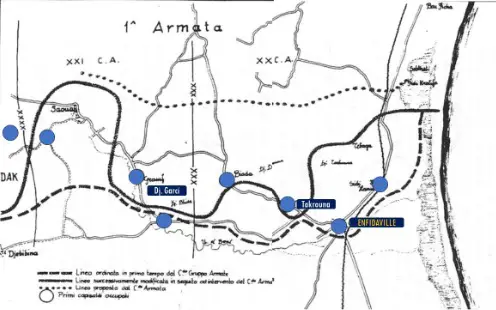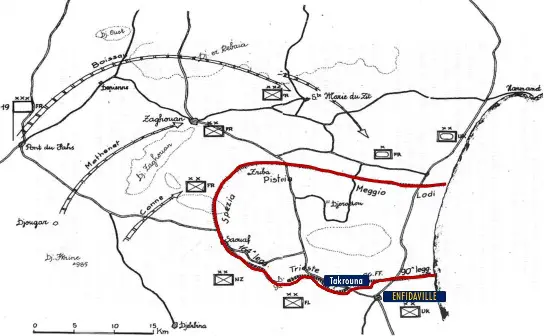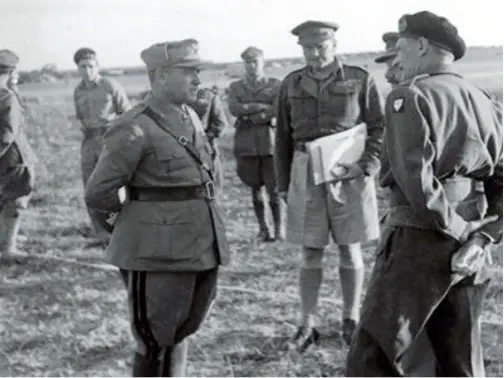The withdrawal
After the retreat from the Wadi Akarit line, the Tunisian campaign finally entered its final phase. Between the 6th and 7th of April, the 1st Italian Army, exhausted by an intense month of fighting, began the withdrawal to the Enfidaville line, 250km to the north. During the movement, the army group commander, Hans Jurgen Von Arnim, opted for a progressive withdrawal, meaning that the 1st Army should have defended a series of successive lines for short periods before getting to the final destination.
General Messe was in sharp contrast with this approach since it gave the chance to the mobile allied units to make contact with the Italo-German formations, resulting in losses of men and precious time. The lack of sufficient transport for men and materials further worsened the capability of the Axis army to mount such elastic withdrawals.
In addition, the flat and open terrain that Messe’s forces had to cross, did not favour any kind of defence, on the contrary, it was very much favourable to armoured thrusts.
In the end, the movement towards Enfidaville cost more men and equipment to the First Army, which however managed to reach the new defensive line by the 13th of April.
The set-up of the new line was another cause of disagreement between Messe and Von Armin. The German commander wanted to establish a defensive perimeter (see the picture below) at the feet of the hilly area behind Enfidaville (dashed line) but this was harshly opposed by Messe, who wanted to exploit the high grounds to the north (dotted line). After some days of inspections, a compromise was reached (black line) and the new defensive positions ran on the hills, forming a line with three arcs and two bulges, where the 1st Army established the strongpoints of Takrouna and Djebel Garci.

The Enfidaville line, blue circles are the main Axis strongpoints
The limited resources (and time) available meant that anti-tank ditches and entrenchments were all but exceptional. In addition, the units of the 1st Army were so depleted that roughly 3.000 men from the logistic services were recalled to join the ranks of the fighting units. By this time, the Centauro and Spezia divisions were empty shells, the Pistoia was left with 2 battalions and 28 artillery guns, the Trieste had 3 battalions and 29 guns, and the Giovani Fasciti had 5 battalions and 27 guns. There were around 6 battalions from the German 164th and 90th divisions, the 15th panzer was down to a dozen tanks and 3 battalions plus some artillery pieces.
The first battle of Enfidaville
At 23:00 on the 19th of April, the British 8th army attacked the Enfidaville line, with an intense artillery barrage, followed by the advance of the 2nd New Zeland division towards Takrouna and the 4th Indian division towards Djebel Garci. The battle raged for almost two days and saw some of the most cruel fights of the entire campaign. On Djebel Garci, the Indians managed to penetrate the line but later the remnants of the Pistoia division partially re-established the line.
At Takrouna, the New Zealanders fought a bloody action against a battalion of the Trieste that garrisoned the strong point. The Italian unit was about to abandon the position when relief came from two companies of Folgore paratroopers (survivors of El Alamein) that recaptured the small village of Takrouna. However, the position was regained on the 21st by another push from a fresh New Zealanders brigade.
The high casualties for the little ground gained, led Montgomery to halt the attack and this came as a great relief for Messe’s unit, which was in a precarious situation, especially in the centre.
At this point, the allies believed that the killing blow to the Axis force could be dealt in the west, against the 5th Panzer Army. Thus, on the 22nd of April, General Anderson’s 1st Army began the attack (Operation Vulcan) and slowly began the advance towards Tunis and Bizerte. The Germans launched furious counterattacks which led the advance to a halt on the 30th of April, but at a high cost.
The final push
Following the halt of Operation Vulcan, the allies redesigned their plans for another push westwards, to begin on the 6th of May, codename Operation Strike. The worsening situation of the 5th army had forced Von Arnim to take units from the already depleted 1st Italian Army and move them to face the British, Americans and French forces to the west.
This came to no results since Operation Strike crushed the last defences of the 5th Panzer Army and Tunis and Bizerte fell already on the 7th of May. This front soon collapsed and General Von Vaerst surrendered on the 9th of May with the remnants of his army.
The once glorious Afrika Corps (DAK), then formed by the 10th and 21st Panzer divisions, which held the junction between Von Vaerst and Messe’s armies, collapsed on the 11th of May. The next time, Von Arnim himself was taken prisoner.
At Enfidaville, Messe ordered his battered units to form a defensive perimeter to the west and to the north, in addition to the one facing south.
In those last moments, the Italian units silently obeyed but several German formations under Messe’s command marched out of their positions and walked to surrender to the allies.
This was the case of the 47° Panzergrenadiere regiment, and elements of the Flak and 90° division. Messe then tried to contact the command of the 8th Army to negotiate a surrender with military honours. The request was refused and Messe did not want to give in.
On the evening of the 12th of May, Mussolini radioed a message to Messe reading “Cease fighting, you are nominated Marshall of Italy, honour to you and to your soldiers”.
On the next day, the 1st Army surrendered to the Allies, finally ending the North African campaign.

The final defensive perimeter of Messe’s Army

Messe meeting Montgomery after the surrender
Sources
Ford, K. (2012) The Mareth line 1943, Osprey publishing
Montanari, M. (1989). Le operazioni in Africa settentrionale, Volume IV: Enfidaville (Parte prima). Roma: Ufficio storico dello stato maggiore dell’esercito.
Jowett, P. (2019). L’esercito italiano nella seconda guerra mondiale. LEG edizioni.